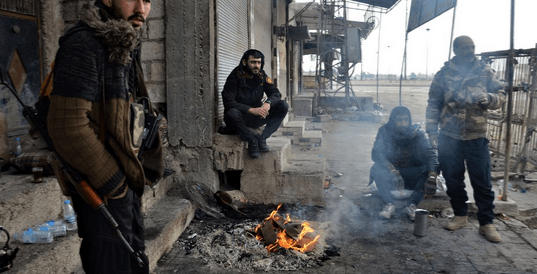
Islamic State plotted comeback long before Syria prison attack
Then last week, nearly 200 terrorists, including suicide bombers, stormed a prison in Syria holding thousands of Islamic State members captive. Undercover terrorists hiding in the civilian population around a facility designed to harbor prisoners escaped. The jihadists started a rebellion inside the prison, which took over the compound.
The prison break was the clearest statement from Islamic State that it remains a deadly threat in Iraq and Syria and a serious challenge to the 900 US troops stationed in the region. The attack sparked a week of firing with American and Syrian troops. More than 100 people were killed, mainly jihadist fighters. About 45,000 people were forced to leave their homes.
The attack again demonstrated that Islamic State could adapt and survive after being ousted from power over an area the size of Britain in Syria and Iraq. Following a decrease in Islamic State activity late last year, the US Defense Intelligence Agency predicted the group would strike violent again after a period of “health and recovery”.
“The insurgency never went away,” said Gregory Waters, a research analyst tracking Islamic State attacks with the Counter Extremism Project, a think tank. “They’re getting stronger.”
Local and Western security officials argue that regional security forces have improved their capabilities since 2014, when Iraq’s forces were facing an attack from Islamic State, making it less likely that the group would regroup in its former state. can gain strength. US officials say Islamic State now poses little threat to the American homeland, although the attackers alone may act in the name of the group.
However, with more than 3,000 US troops in Syria and Iraq, with the main mission of aiding in the fight against Islamic State, the group’s persistence presents a challenge to Washington. The Biden administration has moved to reduce the US military footprint in the Middle East and rely more heavily on Syrian democratic forces to control Islamic State and oversee the prisons and camps that hold its members.
Islamic State has returned to its roots as an extremism, carrying out hit-and-run attacks, thriving on smuggling and extortion and slowly recruiting among marginalized Sunni Muslim Arab communities. Slowly rebuilding his followers. US officials say the group’s command and control hierarchy remains intact, allowing it to launch direct attacks across Syria.
A US official said Islamic State has improved its ability to communicate by coordinating sleeper cells throughout Syria and Iraq and smuggling communication equipment with detainees inside prisons.
Islamic State has exploited the fact that Syrian President Bashar al-Assad lacks the resources to set up security in the country’s vast desert. According to the Office of the Inspector General of the US Department of Defense, the group moved fighters from central Syria to the northeast and Iraq late last year, and carried out mass casualties, including two suicide bombings in Baghdad.
Jail breaks have been a priority for the Islamic State since the death of the caliphate. Just before he was killed in a US airstrike in 2019, former Islamic State leader Abu Bakr al-Baghdadi launched a strategy called “fortress breakout” designed to free jihadist prisoners and raise the group’s ranks. This has led to jailbreaks similar to those of ISIS detainees in the Congo and Afghanistan.
The State Department said last week that attacking Hasakah’s prison in particular has been a priority for the group for at least a year. In November, the SDF said it had foiled an Islamic State plot to attack the prison. Western officials say those warnings point to a failure to secure the SDF-run prison.
“This is a coup for Islamic State. It shows they are still there,” said the European security official. “This is a setback for the SDF. It shows how precarious their holding arrangement is.”
SDF did not respond to a request for comment.
Islamic State used the attack to provide a psychological boost to its followers around the world, with supporters posting handwritten messages and pictures of cakes and sweets. celebrating the attack,
“It’s definitely something that’s going to boost morale among their fighters on the ground,” said Darren Khalifa, a senior Syrian analyst at the International CrIslamic State Group.
Residents and Western officials say Islamic State is quietly spreading its influence in SDF-controlled areas. A European security official says that in the Hasaka region, Islamic State has demanded shop owners and farmers pay taxes – which it calls “zakat”, a form of religious charity. A Syrian activist from Deir Ezor said the group’s leaders paid for truck drivers leaving from oil fields in southeastern Syria. He said those who paid are given a password they give to intercept Islamic State fighters, while those without a code are attacked.
Analysts say drought and economic collapse worsened the situation last year, when job losses and rising food prices fueled Islamic State recruitment. The failure of the SDF-backed administration to restore security and create jobs has added to residents’ grievances.
Extortion has added to the Islamic State’s considerable financial resources. In 2020, fighters in Syria received millions of dollars from money deposited in the region, mostly in Iraq, according to a UN Islamic State panel. It cited the seizure of $1.7 million worth of gold and silver, along with US dollars and Iraqi dinar banknotes buried in Mosul in April 2021.
The group has also strengthened its ranks by freeing people from camps around the world 10,000 people detained when extremists lost their last territory in 2019. Hundreds of women and their children have fled the main camp al-Hol. Western security officials said holding families in northeastern Syria, and other camps holding families of Islamic State members.
Source: Business Hala





